|
|
||||
|
Published by : PROFESSIONAL MEDICAL PUBLICATIONS |
||||
|
ISSN 1681-715X |
||||
|
||||
|
- |
||||
|
ORIGINAL ARTICLE |
||||
|
- |
||||
|
Volume 23 |
October - December 2007 (Part-II) |
Number 6 |
||
|
|
||||
|
|
||||
|
|
||||
|
Published by : PROFESSIONAL MEDICAL PUBLICATIONS |
||||
|
ISSN 1681-715X |
||||
|
||||
|
- |
||||
|
ORIGINAL ARTICLE |
||||
|
- |
||||
|
Volume 23 |
October - December 2007 (Part-II) |
Number 6 |
||
|
|
||||
|
|
||||
The effect of hoemodialysis on pulmonary function tests and
respiratory symptoms in patients with chronic renal failure
Hekmat R1, Boskabady MH2, Khajavi A3, Nazary A4
ABSTRACT
Objective: In the present study the effect of hemodialysis on pulmonary function tests (PFT) and respiratory symptoms of CRF (Chronic Renal Failure) patients was studied.
Methodology: Respiratory symptoms of 18 CRF patients were recorded using a questionnaire, before, in the middle and the end of dialysis. PFT values of patients were also measured in three phases. In addition, baseline PFT values and respiratory symptoms of CRF patients (PFT values and respiratory symptoms before dialysis) were compared with the data of a matched control group of normal subjects (n=18).
Results: Most respiratory symptoms in CRF patients (cough, sputum and breathless) were significantly more prevalent, than control group (p<0.005 to p<0.001). The values of forced vital capacity (FVC), forced expiratory volume in one second (FEV1), peak expiratory flow (PEF), maximal mid expiratory flow (MMEF) and maximal expiratory flow at 75%, 50%, and 25% of the FVC (MEF75, MEF50, and MEF25 respectively) in CRF patients were also significantly lower than control group (p<0.001 for all cases). Most respiratory symptoms of CRF patients at the middle and the end of dialysis were significantly lower than the beginning of dialysis. (p<0.05 to P<0.001). In addition, some respiratory symptoms were also significantly improved at the end compared to the middle of dialysis (p<0.05 for all cases). However, the dialysis did no effect PFT values in CRF patients.
Conclusion: The results of this study showed that dialysis in CRF patients can improve the respiratory symptoms but has no effect on PFT values.
KEY WORDS: Chronic renal failure, Respiratory symptoms, Pulmonary function tests, Hemodialysis.
Pak J Med Sci October - December 2007 (Part-II) Vol. 23 No. 6 862-866
1. Hekmat R,
Dept. of Internal Medicine, Ghaem Medical Centre,
Mashahd University of Medical Sciences,
Mashhad, Iran.
2. Boskabady MH,
3. Khajavi A,
4. Nazary A,
2-4: Department of Physiology,
Ghaem Medical Centre,
Mashhad University of Medical Sciences,
Mashhad Iran.
Correspondence
MH Boskabady, M.D, Ph.D
Email: boskabadymh@mums.ac.ir
mhboskabady@hotmail.com
* Received for Publication: May 30, 2007
* Revision Received: October 1, 2007
* Revision Accepted: October 25, 2007
INTRODUCTION
Changes in the mechanics of lung can occur without any respiratory symptoms and signs in patient with chronic renal failure (CRF). In CRF patients without primary pulmonary disease, these changes include: 1) Reduction of vital capacity which indicates restrictive pulmonary disease without evidence of airway obstruction 2) Negative correlation between lungs diffusing capacity for carbon monoxide (DL
co) and serum level of urea.1,2 3) Increased interstitial fluid in the lung causes edema around the small airways resulting in their earlier obstruction which can be the cause of respiratory disorders in these patients.2 The effect of hemodialysis in CRF patients was mainly related to changes in volume of body fluids. Dialysis leads to decrease in the water content of the lungs which can lead to reduction of pulmonary edema and small airway obstruction.3,4Cardio- pulmonary disorders are the main causes of mortality and morbidity in CRF patients. The goal of dialysis should be improvement of cardio-pulmonary function in these patients. The effect of uremia, on pulmonary function tests due to accumulation of interstitial fluid in the lungs and respiratory muscle weakness was previously demonstrated.
1,2,5,7 It was also shown that hemodialysis can improve PFT values in CRF patients.5 Pleural effusion due to water overload and decreased diffusion lung capacity, can also contribute to pulmonary problems in chronic hemodialized patients.8-10The effects of hemodialysis in patients with CRF are mainly related to changes of volume of body fluid leading to reduction of the amount of water in lungs following dialysis.
1 The respiratory disorders existing in CRF patients with chronic dialysis could be due to chronic edema of lungs around small airways causing obstruction of these airways.10 This could finally lead to lung fibrosis and decrease of pulmonary function tests values.3,4 However, dialysis filter can cause, activation of complement and release of anaphylatoxines which can have a deteriorating effect on respiratory system. Therefore, in CRF patients without primary respiratory diseases, undergoing, chronic long term hemodialysis; theoretically two factors can cause respiratory abnormalities including: 1) Increased interstitial fluid of the lung and pulmonary edema leading to obstruction of small airways and finally lung fibrosis.5 Dialysis of CRF patients could have a beneficial effect on this factor at least in the early stages and can lead to improvement of respiratory symptoms and even PFT values. 2) Immune response resulting from contact of blood, with dialysis bio-incompatible filters, can cause respiratory symptoms.3 In this case dialysis can deteriorate respiratory status.Therefore in this study pulmonary function, tests and respiratory symptoms of CRF patients at the beginning, in the middle and at the end of dialysis were assessed to evaluate the effects of hemodialysis on respiratory status of these patients.
PATIENTS AND METHODS
Subjects: Eighteen CRF patients as study group and 18 normal subjects as control group were selected. CRF patients were recruited from hemodialysis unit, department of nephrology, Ghaem hospital Mashhad,Iran and normal subjects were selected from visitors of the Ghaem hospital. None of the subjects had previously diagnosed respiratory or cardiovascular disease. Only two normal subject of control group were smoker (Table-I). The duration of chronic renal failure and hemodialysis in the patients was between; 1 to 16 and 1-13.5 years respectively (Table-II).
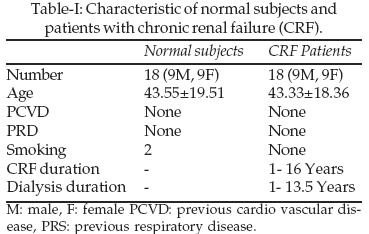
Methods: Respiratory symptoms of CRF patients and normal subjects were recorded using a questionnaire. Respiratory symptoms of CRF patients were recorded three times (at the beginning, in the middle and at the end of dialysis. The questionnaire included questions regarding respiratory symptoms (cough, phlegm, breathlessness and wheezing) according to previous studies,
11-13 smoking habit, and duration of CRF disease and dialysis. Pulmonary function tests of CRF patients and normal subjects were measured using a spirometer with a pneumotachograph sensor (Model ST90, Fukuda, Sangyo Co., Ltd. Japan). Pulmonary function tests (PFT) measurements of CRF patients were also recorded three times (at the beginning, in the middle and the end of dialysis). Prior to pulmonary function testing, the required manoeuvre was demonstrated by the operator, and subjects were encouraged and supervised throughout test performance. Pulmonary function testing was performed using the acceptability standards outlined by the American Thoracic Society (ATS) with subjects in a standing position and wearing nose clips.14 All tests were carried out between 10.00 and 17.00 hours. Pulmonary function tests were performed three times in each subject with an acceptable technique. The highest level for forced vital capacity (FVC), forced expiratory volume in one second (FEV1), peak expiratory flow (PEF), maximal mid expiratory flow (MMEF) and maximal expiratory flow at 75%, 50%, and 25% of the FVC (MEF75, MEF50, and MEF25 respectively) were taken independently from the three curves.
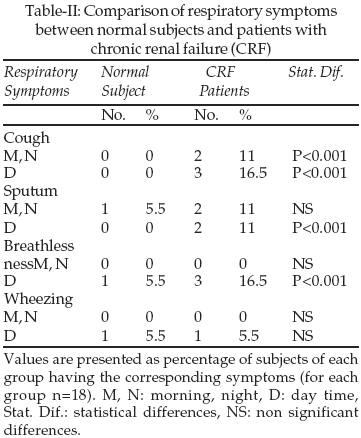
Data analysis: The data of PFT values and age were expressed as meanąSD and data of respiratory symptoms, as percentage of each group having the correspond symptom. Differences in the data of symptoms between CRF patients and normal subjects and between beginnings, middle and the end of dialysis were tested by Fisher exact analysis on 2X2 contingency tables. The data of PFT values and the age between CRF patients and normal subjects were compared using paired t test. Comparison of PFT values between beginning, middle and the end of dialysis was made using, repeated measures analysis of variance (ANOVA) test. P value less than 0.05 was the criterion for statistical significance.
RESULTS
The age of studied subjects: The age of CRF patients (meanąSD age
43.33ą18.36 years) was not significantly different with that of normal subjects (meanąSD age 43.55ą19.51 years, Table-I).Comparison of respiratory symptoms and PFT values between patients with chronic renal failure and normal subjects. Respiratory symptoms in CRF patients including cough, sputum and breathlessness, were significantly higher than normal subjects (p<0.01 to p<0.001, Table-II). In fact 39% of eighteen patients with CRF (7 patients) had respiratory symptoms compared to 6% of control group (1 subject). In addition all PFT values (FVC, FEV
1, PEF, MMEF, MEF75, MEF50, & MEF25) in CRF patients were significantly lower than no- rmal subjects (p<0.001 for all cases,Table-III).
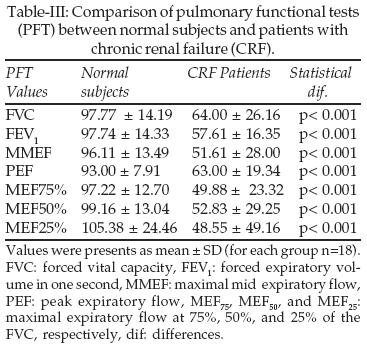
The effect of hemodialysis on respiratory symptoms: All respiratory symptoms (cough, sputum, breathlessness and wheezing) of CRF patients in the middle and at the end of dialysis were significantly lower than the beginning of dialysis (p<0.05 to P<0.001, Table-IV). In addition, some respiratory symptoms (cough, sputum and breathlessness) were also significantly improved at the end compared to the middle of dialysis (p<0.05 for all cases, Table-IV).
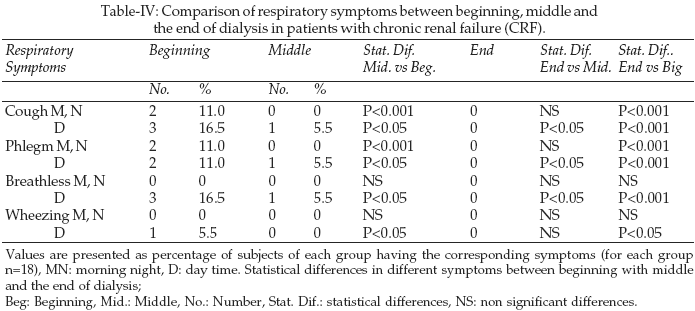
The effect of hoemodialysis on pulmonary function tests: The dialysis did not affect PFT values in CRF patients. There was no significant difference in PFT values of patients with CRF between beginning, middle and the end of dialysis (Table-V).
The effect of hoemodialysis on arterial blood gases and blood pressure: There was no significant difference in arterial blood gases in patients with CRF between beginning, middle and the end of hemodialysis.
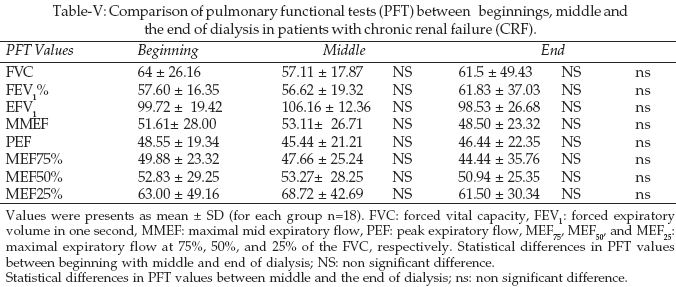
DISCUSSION
The results of the present study shows significantly greater respiratory symptoms and lower PFT values in CRF patient compared to matched normal subjects indicating the presence of respiratory disorders in these patients. Most respiratory symptoms in patients with chronic renal failure were significantly higher, than normal subjects. In addition all PFT values in patients with chronic renal failure were abnormally low (lower than 80% predicted values) and were significantly lower than normal subjects. The results also demonstrate a significant beneficial effect of hemodialysis on respiratory symptoms of these patients. Dialysis leads to significant improvement of respiratory symptoms of CRF patients and patients become symptom free at the end of dialysis. However dialysis did not affect PFT values of CRF patients.
The results of the present study also, showed significant improvement of respiratory symptoms (breathlessness and wheezing) in CRF patients after dialysis. These results also suggest that one of the main causes of respiratory symptoms in these patients is increased interstitial fluid of the lung (pulmonary edema) and obstruction of small airways. Dialysis can reduce pulmonary edema around the small airways which could lead to dilation of the small airways (decrease closing capacity) and increase ventilation especially at the bottom (basal part) of the lung. The absence of a difference in cough and sputum between CRF patients and normal subjects is perhaps due to the effect of pulmonary edema on small airway causing mainly breathlessness and wheezing rather than producing cough and phlegm. Therefore dialysis did not affect cough and sputum.
The dialysis did not improve the reduced PFT values. The absence of the effect of dialysis on PFT values may indicate lung fibrosis and permanent reduction in PFT values. Increased interstitial lung fluid in CRF patients can obstruct small airway which would not affect PFT values. Therefore dialysis can reduce pulmonary edema, dilate the small airways and improve respiratory symptoms without affecting PFT values. In fact most of the studied CRF patients had long duration of both renal disease and dialysis. Therefore it would be worthdwhile if CRF patents with shorter duration of the disease were studied in this regard in further studies.
Increased serum PTH level in CRF patients can probably induce hypercalcaemia and lead to induction of small calcifications in lung tissues
4 which are not apparent in chest radiography, resulting in decreased lung diffusion capacity (DLco). Early and more effective hemodialysis and better control of, calcium, phosphor and parathormone homeostasis in uremic patients can probably better preserve lung diffusion capacity.In conclusion the results of this study show that dialysis can improve respiratory symptoms without affecting PFT values.
REFERENCES
1. Kohen JA, Opsahl JA, Khellstrand CM. Deceptire patterns of uremic pulmonary edema. Am J Kidney Dis 1980;7:456-9.
2. Zidulka A, Dutoit PJ, Milic-Emili J, Anthonisen NR. Pulmonary function with chioncc uremia. Am J Med 1973;55:134-8.
3. Prezant DJ. Effect of uremia and its treatment on pulmonary function. Lung 1990;168:1-14.
4. Dujic Z, Tocilj J, Ljutic D, Eterovic D. Effects of hemodialysis & anemia on pulmonary diffusing capacity, membrane diffusing capacity and capillary blood volume in uremic patients. Respiration 1991;58:277-81.
5. Fairshter RS, Vaziri ND, Mirahmadi MK. Lung pathology in chronic hemodialysis patients. Int J Artif Organs 1982;5:97-101.
6. Bush A, Gabriel R. Pulmonary function in chronic renal failure: Effects of dialysis and transplantation. Thorax 1991;46:424-8.
7. Bush H, Heimer D, Chaimovitz C. Effect of chronic renal failure on respiratory muscle strength. Respiration 1988;54:153-61.
8. Jarrat MJ, Sahn SA. Pleural effusions in hospitalized patients receiving long- term hemodialysis. Chest 1995;108:470-4.
9. Moinard J, Guenard H. Membrane diffusion of the lungs in patients with chronic renal failure. Eur Resp J 1993;6:225-30.
10. Slutsky RA, Day R, Murray M. Effect of prolonged renal dysfunction of intravas- cular and extravascular pulmonary fluid volumes during left atrial hypertension. Proc Soc Exp Biol Med 1985;179:25-31.
11. National Institute of Health. Global strategy for asthma management and prevention: NHBLI workshop report. Bethesda, MD, January, Publication No. 023659. 2002.
12. Boskabady MH, Fasihfar M. Correlation between symptom score, reversibility of pulmonary function tests and treatment response in asthma. J Allergy Asthma Immunol 2003;2:61-7.
13. Boskabady MH, Azdaki N. Effect of inhalation technique on the bronchodilatory response to the salbutamol Inhaler in asthmatic patients. Turkish Respir J 2005;6:10-14.
14. American Thoracic Society. Standardization of spirometry: 1994 Update. Official Statement of American Thoracic Society. Am J Respir Crit Car Med 1995;152:1107-36.
HOME | SEARCH | CURRENT ISSUE | PAST ISSUES
Professional
Medical Publications
Room No. 522, 5th Floor, Panorama Centre
Building No. 2, P.O. Box 8766, Saddar, Karachi - Pakistan.
Phones : 5688791, 5689285 Fax : 5689860
pjms@pjms.com.pk